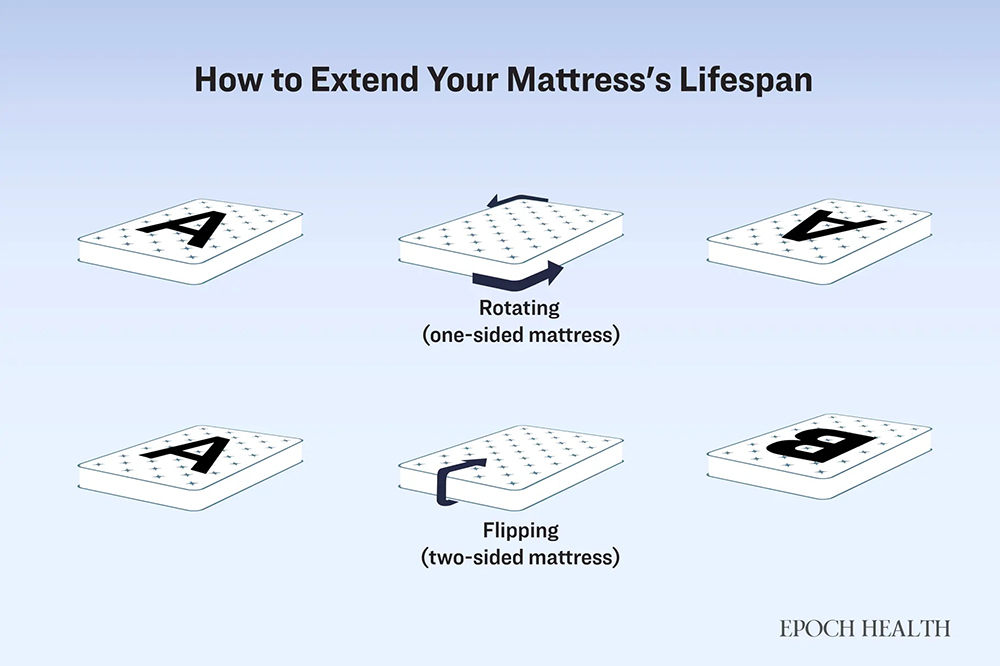|
Getting your Trinity Audio player ready...
|
By: Flora Zhao
A friend of mine who is a magazine editor shared a story with me: She had been experiencing persistent discomfort, including neck and back pain, that would not resolve despite her trying various remedies. One day, on a whim, she decided to replace her 10-year-old mattress. To her surprise, her symptoms disappeared within a few days.
“A lot of people wake up in the morning and they will have a stiff back or a sore back. That may be a sign that the mattress is getting older,” Bert Jacobson, M. B. “Bud” Seretean endowed professor and regents professor at the School of Kinesiology, Applied Health, and Recreation at Oklahoma State University, told The Epoch Times.
Over the past two decades, Jacobson has led and participated in a series of studies on mattresses. He has identified a common phenomenon: When people switch to a new mattress, the symptoms that once troubled them often disappear. In his research, many individuals reported no longer experiencing stiffness and pain upon waking, feeling more refreshed and having less psychological stress.
He noted that people may not realize that all these discomforts are related to “what you sleep on.”
The Lifespan of a Mattress
“The average age of a mattress is around 10 years old,” Jacobson said.
In one of his earlier studies, 59 healthy participants who used the same mattresses for an average of 9.5 years reported mild sleep-related pain and compromised sleep quality. After switching to a new medium-firm mattress for four weeks, they experienced a 48 percent reduction in back pain, a 55 percent improvement in sleep quality, and an approximately 20 percent decrease in stress.
Another study involved participants whose mattresses had been in use for 11.3 years. They exhibited significant health improvements after switching to new mattresses. Their physical stress scores dropped significantly from 2.57 to 1.73, psychological stress decreased from 1.70 to 1.37, and they slept longer.
How a mattress supports your body can even influence mood. A new study published in April 2024 showed that middle-aged individuals with occasional insomnia who switched to a medium‐firm grid mattress experienced significant improvements in self-reported sleep duration, fatigue, and daytime mood, including tension, anger, esteem, and vigor.
Heather A. Hausenblas, the study’s corresponding author and a professor of exercise science at the Brooks Rehabilitation College of Healthcare Sciences at Jacksonville University, told The Epoch Times that replacing a mattress is a simple change yet can have a profound impact.
The improvements observed in the study prompted her to replace her own old mattress with a new one over a year ago. “I find it extremely comfortable,” she said.
Recognizing that simply replacing a mattress can alleviate or eliminate pain and discomfort, Jacobson designed a study to examine the wear and tear of old mattresses, focusing on the most commonly used spring mattresses.
He and his colleagues collected 32 old mattresses, the average age of which was nine years. By extracting and testing the weight-bearing springs from the center of the mattresses, as well as the non-weight-bearing springs from the head and foot, they found that although the mattresses appeared flat and the springs looked normal, the weight-bearing springs were weaker than the non-weight-bearing springs due to years of compression.
Specifically, when approximately 2.2 pounds of weight was applied to both types of springs, the weight-bearing springs were compressed by an average of 1.09 inches. In contrast, the non-weight-bearing springs were compressed by little more than half an inch, highlighting a significant difference.
Some people believe that their mattresses, despite years of use, are still in good condition, but this is just an illusion. Jacobson explained that non-weight-bearing areas of the mattress can appear visually flat, and since a bedspread always covers them, the mattress may even look relatively new. However, even a small amount of weight can cause significant deformation in the weight-bearing springs, potentially compromising their original structural support. This can result in poor sleep posture and a decline in sleep quality.
Factors at Play
How often a mattress should be replaced varies by material.
“Innerspring mattresses usually need replacing quicker than other mattresses due to wear and tear on the springs, while memory foam and latex mattresses may last longer because of their more resilient materials,” Shelby Harris, director of Sleep Health at Sleepopolis and a licensed clinical psychologist who specializes in behavioral sleep medicine, told The Epoch Times. “The replacement interval also depends on the quality of the mattress and how well you take care of it.”
It also depends on its condition. “If it is no longer comfortable and is implicated in sleep disturbance,” it’s time to replace it, said Moira Junge, CEO of the Sleep Health Foundation in Australia, adjunct clinical associate professor at Monash University, and health psychologist, during an email interview with The Epoch Times.
It is worth noting that even mattresses made from the same or similar materials can vary in lifespan. For example, low-density memory foam mattresses tend to have shorter lifespans than high-density ones. Similarly, synthetic latex mattresses generally do not last as long as natural latex ones.
For an average-quality mattress, most experts who are asked generally agree on a replacement time of seven to 10 years.
However, heavier individuals tend to wear out a mattress more quickly. “I once had a new customer who weighed 300 pounds and told me he had to replace his mattress every year,” Lee Carter, president of Sleep Essentials, Inc., told The Epoch Times. Carter then recommended one of his high-quality latex mattresses to the customer. “It has been several years now, and he is still using that mattress without needing to come back for a replacement.”
When people consider how long their mattress will last, they often think of the 20- or 25-year warranty offered by the retailer at the time of purchase. However, these warranties mainly cover the mattress’s core structure and specific components. They do “not guarantee the comfort or the support,” Jacobson emphasized. The wording of these warranty contracts or guarantees is often subtle, if not vague. The key details are typically hidden in the fine print, where exclusions or specific conditions are outlined.
However, he also noted that mattresses with an extended warranty period are likely better than those with no warranty at all.
Other Threats Within Old Mattresses
Dust Mites and Allergens
An old mattress not only compromises support for your body but can also lead to other problems.
For example, dust mites can thrive in an old mattress. Human skin renews itself constantly, shedding an average of 1.5 grams of dead skin cells each day. This amounts to roughly 1.1 pounds of skin flakes annually, most of which becomes “house dust.”
The continuous shedding and accumulation of skin cells in the environment is not a problem in and of itself. The real problem is that these skin cells serve as food for dust mites. Old mattresses often harbor large populations of these mites. They are microscopic, measuring about 0.4 millimeters in length, invisible to the naked eye. They thrive in warm, humid conditions with ample food, making mattresses their ideal habitat.




